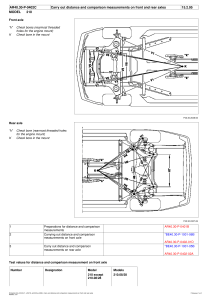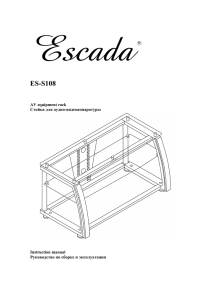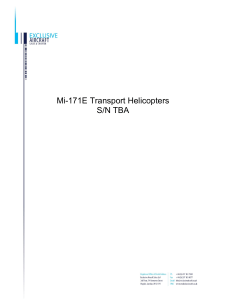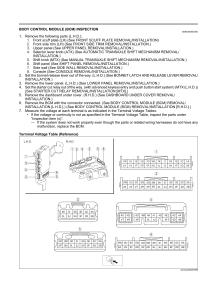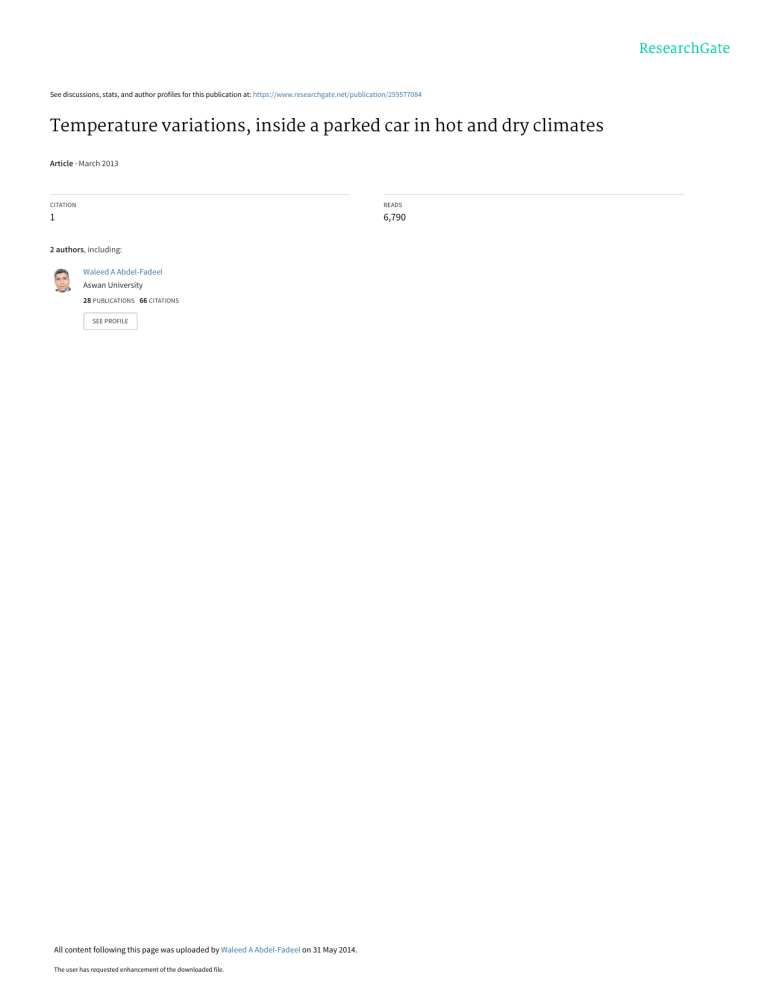
See discussions, stats, and author profiles for this publication at: https://www.researchgate.net/publication/259577084 Temperature variations, inside a parked car in hot and dry climates Article · March 2013 CITATION READS 1 6,790 2 authors, including: Waleed A Abdel-Fadeel Aswan University 28 PUBLICATIONS 66 CITATIONS SEE PROFILE All content following this page was uploaded by Waleed A Abdel-Fadeel on 31 May 2014. The user has requested enhancement of the downloaded file. International Journal of Automobile Engineering Research & Development (IJAuERD) ISSN 2277-4785 Vol. 3, Issue 1, Mar 2013, 75-80 © TJPRC Pvt. Ltd. TEMPERATURE VARIATIONS IN A PARKED CAR EXPOSED TO DIRECT SUN DURING HOT AND DRY CLIMATES WALEED A. ABD-FADEEL & SOUBHI ALI HASSANEIN Assistant Prof. of Mech. Eng Dept, Faculty of Energy Engineering, Aswan University, Egypt ABSTRACT The temperature levels inside a car parked in the sun on a hot summer day in Aswan can be as much as 80 oC above that outside the car. The heat input into the cabin is primarily from solar radiation passing through the car glasses which called the greenhouse effect. The temperature is measured at four different places inside the cabin. Four thermometers are used to measure the temperature at front dash board, rear board, front seat, and rear seat. The effect of car orientation on the cabin temperature are studied by facing the car towards the main four directions, North, South, East, and West. Cracking the windows of the car by 1 and 3 cm is not sufficient to reduce the cabin temperature. Covering the front and rear glasses with a car sunshade reduces the temperature of rear and front dash boards by about 50 oC. KEYWORDS: Temperature Variation, Parked Vehicle, Hot and Dry Climates, Direct Sun, Solar Radiation INTRODUCTION The cabin temperature of closed stationary vehicles in direct sunlight can quickly rise to a level that may damage property and harm children or pets left in the vehicle. The problem that is faced by many car users today is a hot interior after certain minutes or hours of parking in open air or un-shaded parking area. The accumulation of thermal energy inside the vehicle with undesired temperature rise would cause the interior parts to degrade because they normally are subjected to wear and tear. Degradation may shorten the life span of the various components inside the car. Passengers are also being affected with the thermal condition inside the vehicle itself. The car user is forced to wait for a period of time before getting into the car to cool down the interior condition either by rolling down the window or running the air conditioner at high speed that really affect the fuel consumption. The objective of this study is to determine the temperature variation in a parked car exposed to direct sun during a hot and sunny day in Aswan. The temperature rises in parked vehicle is mainly due to solar radiation and green house effect. Solar radiation enters the car through the glasses and is partially trapped with in the car.The measured temperature inside a parked car in a summer days (June) in Aswan, (Egypt) could reaches to 120°C where outside temperature is ranging from 35 - 45°C. The measurements takes place at different conditions of closed and opened windows of parked car. Dadour et al. [1] demonstrated that when a vehicle is parked in the sun in summer in Western Australia, temperature levels in the cabin of the vehicle can be more than 20 oC above the ambient temperature. They developed a simple ‘greenhouse’ model for predicting the daily internal vehicle temperatures. They also predicted the temperatures inside the cabin of black and white vehicles. They shoed that lowering the driver’s window of the vehicle by 2.5 cm typically reduces cabin temperatures by about 3 oC, which is not sufficient to reduce significantly the safety concerns for children or pets left in parked vehicles. Kaynakli and Kilic [2] measured temperature and humidity at a number of points inside a 1991 model Toyota Corona Sedan automobile equipped with a 2000 cc engine during heating period. Korukcu and 76 Waleed A. Abd-Fadeel & Soubhi Ali Hassanein Kilic [3] used infrared thermography to measure the instant and transient temperature distributions of all surfaces inside an automobile and investigate the thermal discomfort that was caused by those surfaces. Mezrhab and Bouzidi [4] presented a numerical model to study the behaviour of thermal comfort inside the passenger car compartment according to climatic conditions and materials that compose the vehicle. They developed numerical model taking into account of the combined convection, conduction, and radiation heat transfer. EXPERIMENTAL SETUP A blue Mazda 323 (Model 1982) and car sunshade shown in Fig. 1 are used in the experiments. The shape and dimensions of the side, rear, and front glasses are shown in the Fig. 2. All side windows are made of white transparent glass. The front and rear glasses are also made of white glass. The car sunshade has a silver foil front and back. EXPERIMENTAL PROCEDURES The car was parked and exposed to direct sun rays at a free air all the day in Aswan (latitude 24, longitude 32). The car was divided into four sections, dash board, front seats, rear seats, and rear board as shown in Fig. 3. Four identical thermometers are fixed on each section to measure the temperature during the time. The temperature variation at the four places inside the cabin is measured four times during four days at almost constant atmospheric temperatures in June. Every day during the daily hours, the car was facing toward one direction of the four main directions (North, South, East, and West). The temperature variation at the four places inside the cabin is also measured six times during six days at almost constant atmospheric temperature in June. All experiments are made almost at the same conditions (car direction and daily hours). The temperature is measured when the car was totally closed, lowering the driver’s window by 1 cm, lowering the front two windows by 1 cm, lowering the four windows by 1 cm, lowering the four windows by 3 cm, and covering the front and rear glasses with a car sunshades. RESULTS Irradiation Measurement The average global solar radiation is measured in a normal plane to the sun. The amount of irradiative heating in Aswan from 7 am to 7 pm in June (the solar power incident on a square meter) is shown in Fig. 4. It could be seen that irradiation increases with time to maximum values between 11 am to 3 pm. The maximum irradiance reading was 1106 w/m2 approximately at 1 pm. Temperature Distribution inside the Closed Car at Different Orientations Fig. 5(a, b, c, and d) shows the temperature variation in the front dash board, rear seat, rear board, and front seat compared with the outside temperature. These temperature variations are measured when the closed car was faced to the north, south, east, and west from 7 am to 7 pm. The cabin air temperature rises in the morning more rapidly than does the outside air. It is also observed that the cabin air temperature cools in the afternoon more rapidly than does the outside air. The time of the maximum cabin temperature (about 120 oC) is quite close to the time of the maximum of the outside air (about 40 oC). The temperature of front and rear boards is always greater than that of front and rear seats. This is because, the largest amount of solar radiation passes into the car when the largest projected area of glass is facing to the sun’s rays. All Cars have large windscreens compared with other windows. For example, as shown in Fig. 5(a), while the car was facing north, the front dash board was the largest projected area of glass facing to the sun’s rays. After midday, the rear Temperature Variations in a Parked Car Exposed to Direct Sun during Hot and Dry Climates 77 board was the largest projected area of glass facing to the sun’s rays which leads to transmit the greatest amount of the solar radiation into the car. Temperature Distribution inside the Car at Cracked Windows and Car Sunshade The effect of opening the driver’s side window by 1 cm, front side windows by 1 cm, four side windows by 1 cm, and four side windows by 3 cm on a hot summer day at different places inside the car is shown in Fig. 6. The temperature is measured during about an hour from 12 pm to 1 pm. The effect of opening windows is approximately neglected at the four places (front dash board, front seat, rear seat, and rear board) inside the car. The windows gap is very small to let sufficient fresh air flows from outside and circulates inside the car. The wind speed inside the car is very small to reduce the temperature inside the car. The effect of car sunshade is also studied as shown in Fig. 6. Its effect is neglected at the front and rear seats because the seats is already shaded by the ceiling of the car. However, the temperature at the seats does not exceed 60 oC while it reaches 120 oC at the front and rear boards. The car sunshade reduces the temperature at front and rear boards by about 40-60 oC compared with closed car. CONCLUSIONS The cabin temperature increases in the morning and decreases in the afternoon more rapidly than does the outside air. The time of the maximum cabin temperature (about 120 oC) is quite close to the time of the maximum of the outside air (about 40 oC). The temperature of front and rear boards is always greater than that of front and rear seats because they have the largest projected area of glass facing to the sun’s rays. Opening windows about (1-3 cm) fails to reduce the temperature inside the car because the flow rate of fresh air entering the car is not sufficient and its velocity inside the car is approximately neglected. The car sunshades have no effect at the front and rear seats because they already shaded by the ceiling of the car while they reduce the temperature at front and rear boards by about 40-60 oC. REFERENCES 1. I.R. Dadour, I. Almanjahie, N. D. Fowkes, G. Keady, K.Vijayan, Temperature variations in a parked car, Forensic Science International 207 (2011) 205-211. 2. O. Kaynakli, M. Kilic, An investigation of thermal comfort inside an automobile during the heating period, Applied ergonomics 36 (2005) 301-312. 3. M. O. Korukcu, M. Kilic, The usage of IR thermography for the temperature measurements inside an automobile cabin, International communications in heat and mass transfer 36 (2009) 872-877. 4. A. Mezrhab, M. Bouzidi, Computation of thermal comfort inside a passenger car compartment, Applied Thermal Engineering 26 (2006) 1697–1704. APPENDICES Figure 1: A Blue Mazda 323, Model 1982 and Car Sunshade 78 Waleed A. Abd-Fadeel & Soubhi Ali Hassanein Figure 2: Car Schematic Figure 3: Measuring Places inside the Cabin 1200 800 2 Solar flux (W/m ). 1000 600 400 200 0 5 10 15 20 Daytime hours Figure 4: Measured Average Global Solar Radiation on a Horizontal Surface 79 Temperature Variations in a Parked Car Exposed to Direct Sun during Hot and Dry Climates 140 Outside Front dash board Rear seat Rear board Front seat 120 (a) Facing North o Temperature ( C) 100 80 60 40 20 0 5 10 15 20 Daytime hours 140 Outside Front dash board Rear seat Rear board Front seat 120 o Temperature ( C) 100 (b) Facing South 80 60 40 20 0 5 10 15 20 Daytime hours 140 Outside Front dash board Rear seat Rear board Front seat 120 (c) Facing East o Temperature ( C) 100 80 60 40 20 0 5 10 15 20 Daytime hours 140 Outside Front dash board Rear seat Rear board Front seat 120 o Temperature ( C) 100 (d) Facing West 80 60 40 20 0 5 10 15 20 Daytime hours Figure 5: The Effect of Vehicle Orientation on the Temperature Distribution inside Closed Car (June in Aswan) 80 Waleed A. Abd-Fadeel & Soubhi Ali Hassanein 120 (a) Front dash board o Temperature ( C) 100 80 60 40 Closed windows Two cracked windows (1cm) Four cracked windows (3 cm) 20 One cracked window (1cm) Four cracked windows (1cm) Car sunshade 0 12 12.5 13 13.5 Daytime hours 120 (b) Front seat o Temperature ( C) 100 80 60 40 Closed windows Two cracked windows (1cm) Four cracked windows (3 cm) 20 One cracked window (1cm) Four cracked windows (1cm) Car sunshade 0 12 12.5 13 13.5 Daytime hours 120 (c) Rear seat o Temperature ( C) 100 80 60 40 Closed windows Two cracked windows (1cm) Four cracked windows (3 cm) 20 One cracked window (1cm) Four cracked windows (1cm) Car sunshade 0 12 12.5 13 13.5 Daytime hours 120 (d) Rear board o Temperature ( C) 100 80 60 40 Closed windows Two cracked windows (1cm) Four cracked windows (3 cm) 20 One cracked window (1cm) Four cracked windows (1cm) Car sunshade 0 12 12.5 13 13.5 Daytime hours Figure 6: The Effect of Cracked Windows and Car Sunshade on the Temperature, Distribution inside the Car (June in Aswan) View publication stats
